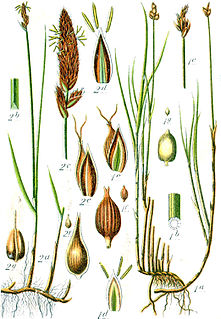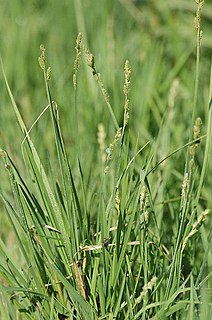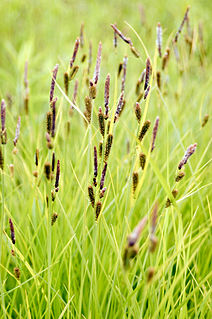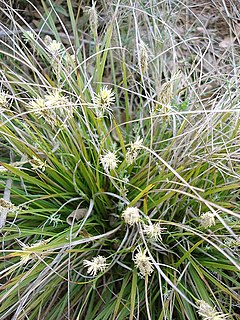
Ornamental grasses are grasses grown as ornamental plants. They have become increasingly popular in gardens in recent years. Ornamental grasses are popular in many colder hardiness zones for their resilience to cold temperatures and aesthetic value throughout fall and winter seasons.

Note that information on this species applies to Western Europe and some details may not be consistent with the species in other parts of its range.
NVC community M4 is one of the mire communities in the British National Vegetation Classification system.

Carex chordorrhiza, commonly called creeping sedge or string sedge, is a species of perennial plant in the family Cyperaceae with Holarctic distribution growing in acidic bogs.

Carex canescens L. is a perennial species of plants in the family Cyperaceae growing in damp forests and wetlands. It is widespread across much of Europe, Asia, Australia, New Guinea, North America, and southern South America.

Carex rostrata, the bottle sedge or beaked sedge, is a perennial species of sedge in the family Cyperaceae.

Carex stricta is a species of sedge known by the common names upright sedge and tussock sedge. It is grass-like and can be difficult to distinguish from other plants, because of its long, triangular, green stems. The plant grows in moist marshes, forests and alongside bodies of water. It grows up to 2 feet (0.61 m) tall and 2 feet (0.61 m) wide. When the leaves die, they build on top of or around the living plant, making a "tussock". It is one of the most common wetland sedges in eastern North America.

Lithacodia uncula, the silver hook, is a species of moth of the family Noctuidae. It is found in the Palearctic ecozone.

Carex diandra is a species of sedge known by the common names lesser tussock-sedge and lesser panicled sedge.

Carex rossii, commonly known as Ross's sedge, is a hardy species of sedge that is often a pioneer species in areas with little or no established vegetation, or in places where disturbance has occurred. It flowers in May and June.

Carex utriculata is a species of sedge known as Northwest Territory sedge and common yellow lake sedge.

Carex vesicaria is an essentially Holarctic species of sedge known by the common names bladder-sedge and blister sedge. The dried fibers, sometimes used as thermal insulation in polar regions, are known as sennegrass, saennegrass or similar, from the plant's Bokmål name sennegras.

Carex pensylvanica is a species of flowering plant in the sedge family commonly called Pennsylvania sedge. Other common names include early sedge, common oak sedge, and yellow sedge.

Carex disticha is a Eurasian species of sedge known as the brown sedge or, in North America, tworank sedge.

Carex sect. Spirostachyae is a section of the genus Carex, containing 38 species of sedge. Species in Carex sect. Spirostachyae share a suite of features, including the short internodes of the primary rhizomes, the presence of an antiligule, the leaf-like, sheathing bract at the base of the inflorescence, the presence of three stigmas in female flowers, and the shape of the seeds.

Triphysa nervosa is a butterfly of the family Nymphalidae. It is found in northern Transuralia, the mountains of southern Siberia, eastern Siberia, Amurland, the Russian Far East, Korea, northern and north-eastern China and Mongolia.

Carex panicea, commonly known as carnation sedge, is a plant species in the sedge family, Cyperaceae. It is known as grass-like sedge and can be found in Northern and Western Europe, and also in north-eastern North America. The plant produces fruits which are 3–4 millimetres (0.12–0.16 in) long, are egg shaped and spiked. Both male and female species leaves are pale blue on both sides.


















